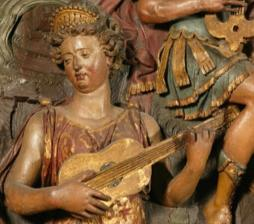Muse playing a vihuela. Detail from anon. “Apollo and the Muses”. English, c.1580.
(1580) - London, Victoria and Albert Museum. Provenance: the Manor House, Toddington, Bedfordshire (?)
instrument: vihuela de mano | century: 16cent/3/late | catalogue nº: 16-309

Artwork
Creator anon
Medium Artwork: Sculpture
Location
City Toddington | Region England | Old kingdom Lowcountries
Characteristics
| Body Waisted | Strings 6 strings | Neck Medium | Pegbox Sickle |
| Bridge Obscured | Frets No | Back Not visible | Pegs Lateral |
| Technique Plucked fingers |
Commentary
ARTWORK
Apollo and the Muses. Carved painted and gilt oak Panel, ca.1580. London, Victoria and Albert Museum, Museum no. A.12-1924. Height: 121.28 x Width: 178.18. According the details on the V&A website, the work is probably Engish and is said to have come from the Manor House, Toddington, Bedfordshire. The panel formed part of the Temple of the Muses at the Grange, Hockliffe, Bedfordshire. It is said to have come from the Manor House, Toddington, Bedfordshire, which was built in the 1570s and demolished in 1745.
The panel depicts Apollo and the Nine Muses, represents the Arts in general, suitable for an important chamber of a grand house, especially as an overmantels in the most prominent part of the room. This carving is characteristic of English work of the 1580s and similar to other English examples. Here, Apollo plays the lyre while the nine muses play the following instruments (from left to right): lyre, recorder, viola da braccio, viola da mano, hurdy-gurdy, lute, triangle and oboe (added later, as oboes were not invented until 1650).
INSTRUMENT
Small six-course vihuela (depicted as six strings), with central soundhole, and obscured bridge. It is presumably flat- backed, has a long neck that finishes in a sickle pegbox, possibly indicating to be copied from an Italian model. Held in playing position by an Apollonian muse.
Reproductions
http://collections.vam.ac.uk/item/O77786/apollo-and-the-nine-muses-panel-unknown/